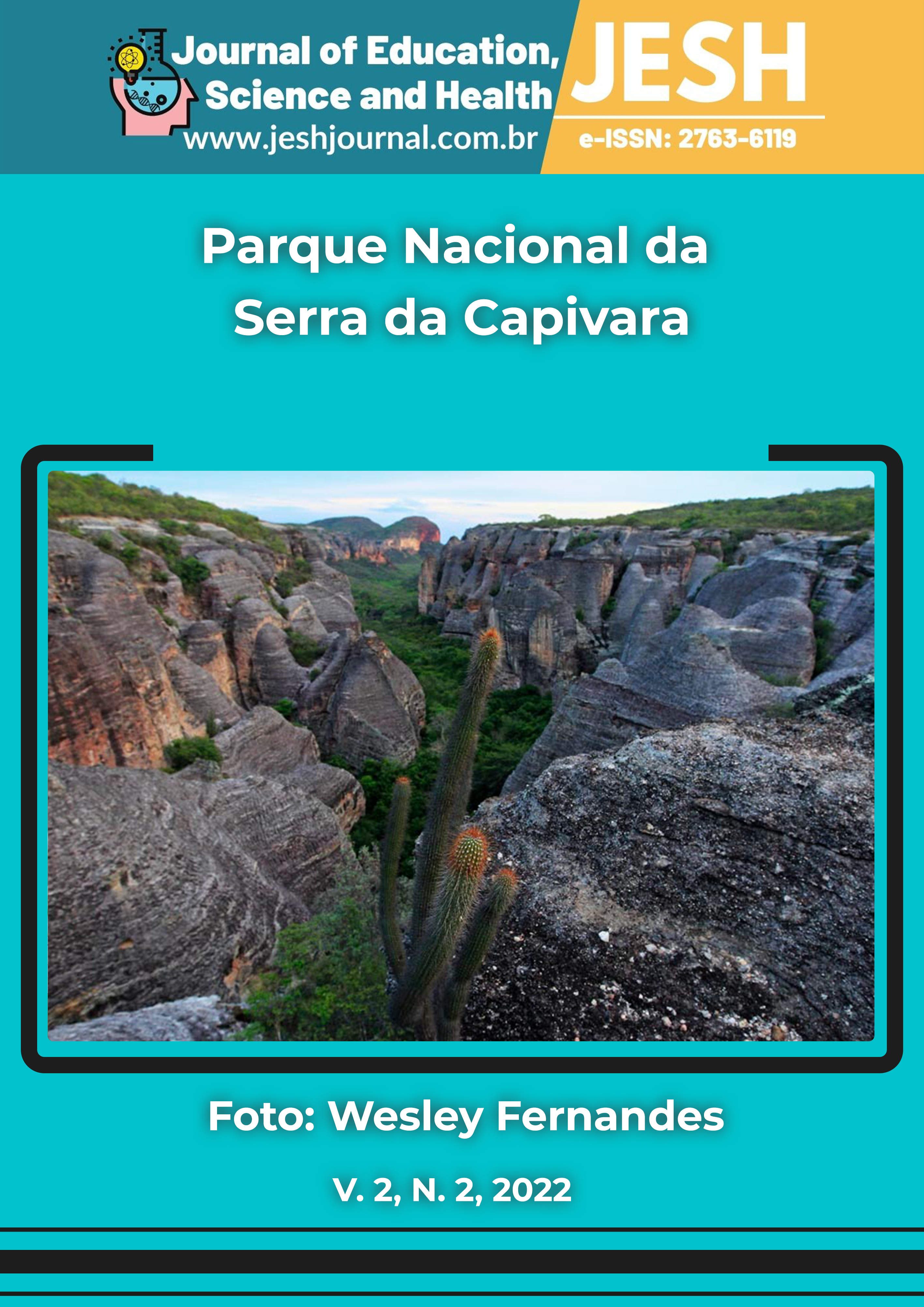Análise da interação do contaminante metilmercúrio com hemoglobina do peixe matrinxã Brycon cephalus (Günther, 1869)
Analysis of the interaction of the contaminant methylmercury with hemoglobin from the fish matrinxã Brycon cephalus (Günther, 1869)
DOI:
10.52832/jesh.v2i2.132Palavras-chave:
Contaminantes, Mercúrio, Peixes, ToxicidadeResumo
Os danos ambientais devido a um meio ambiente desequilibrado causam problemas muitas vezes irreversíveis à biota. O aumento da população desencadeia o aumento da produção industrial e do consumo, sendo que muitas vezes tanto as indústrias como os indivíduos não descartam de forma correta seus resíduos, causando contaminação no ar, solo e água. Na água os contaminantes podem sofrer o processo de bioacumulação e bimagnificação, chegando aos seres humanos através do consumo de peixes, por exemplo. O metilmercúrio é uma forma tóxica do mercúrio, sendo altamente poluente e contaminante quando em contato com os seres vivos. O objetivo desta pesquisa foi o de verificar o padrão de interação entre o metilmercúrio e a hemoglobina do peixe Brycon cephalus através de docking molecular. A energia livre de ligação obtida para o complexo hemoglobina-metilmercúrio foi de -2.0 kcal/mol. Seis aminoácidos da hemoglobina foram envolvidos na ligação com o metilmercúrio, sendo eles: Valina, Serina, Leucina Arginina e Fenialanina. O docking molecular indicou a tendência de ligação do mercúrio à hemoglobina Brycon cephalus que pode gerar danos ao metabolismo. Assim, novos experimentos complementares (in vitro e in vivo) devem ocorrer para avaliar o possível efeito tóxico do metilmercúrio sobre essa espécie.
Downloads
Métricas
Referências
Berman, H. M. (2000). The Protein Data Bank. Nucleic Acids Research, 28(1), 235–242. https://doi.org/10.1093/nar/28.1.235 DOI: https://doi.org/10.1093/nar/28.1.235
Bolton, E. E., Wang, Y., Thiessen, P. A., & Bryant, S. H. (2008). PubChem: Integrated Platform of Small Molecules and Biological Activities. Annual Reports in Computational Chemistry, 217–241. https://doi.org/10.1016/s1574-1400(08)00012-1 DOI: https://doi.org/10.1016/S1574-1400(08)00012-1
Chan, P. H. Y., Chan, M. H. M., Li, A. M., Cheung, R. C. K., Yu, X. T., & Lam, H. S. (2018). Methylmercury levels in commonly consumed fish and methylmercury exposure of children and women of childbearing age in Hong Kong, a high fish consumption community. Environmental Research, 166, 418–426. https://doi.org/10.1016/j.envres.2018.06.033 DOI: https://doi.org/10.1016/j.envres.2018.06.033
Donald, D. B., Wissel, B., & Anas, M. U. M. (2015). Species-specific Mercury bioaccumulation in a diverse fish community. Environmental Toxicology and Chemistry, 34(12), 2846–2855.https://doi.org/10.1002/etc.3130 DOI: https://doi.org/10.1002/etc.3130
Gimenes, T. C., Penteado, J. O., dos Santos, M., & da Silva Júnior, F. M. R. (2021). Methylmercury in Fish from the Amazon Regiona Review Focusedon Eating Habits. Water, Air, &SoilPollution, 232(5). https://doi.org/10.1007/s11270-021-05151-x DOI: https://doi.org/10.1007/s11270-021-05151-x
Gadelha, E. S., Araújo, J. C. (2013). Criação de Matrinxã em cativeiro. Pubvet 7(5). DOI: https://doi.org/10.22256/pubvet.v7n5.1507
Hanwell, M. D., Curtis, D. E., Lonie, D. C., Vandermeersch, T., Zurek, E., & Hutchison, G. R. (2012). Avogadro: an advanced semantic chemical editor, visualization, and analysis platform. Journal of Cheminformatics, 4(1). https://doi.org/10.1186/1758-2946-4-17 DOI: https://doi.org/10.1186/1758-2946-4-17
Hsu-Kim, H., Kucharzyk, K. H., Zhang, T., Deshusses, M. A. (2013). Mechanisms Regulating Mercury Bioavailability for Methylating Microorganisms in the Aquatic Environment: a critical review. Environmental Science & Technology, 47(6), 2441-2456. http://dx.doi.org/10.1021/es304370g. DOI: https://doi.org/10.1021/es304370g
Lescord, G. L., Johnston, T. A., Branfireun, B. A., Gunn, J. M. (2018). Percentage Of Methylmercury In The Muscle tissue of freshwater fish varies with body size and age and among species. Environmental Toxicology And Chemistry, 37(10), 2682-2691. http://dx.doi.org/10.1002/etc.4233. DOI: https://doi.org/10.1002/etc.4233
Li, P., Feng, X., Qiu, G. (2010). Methylmercury Exposure and Health Effects from Rice and Fish Consumption: a review. International Journal Of Environmental Research And Public Health, 7(6), 2666-2691. http://dx.doi.org/10.3390/ijerph7062666. DOI: https://doi.org/10.3390/ijerph7062666
Lima, F. C. T. (2003). Subfamily Bryconinae (Characins, Tetras). In: Reis, R. E, Kulander, S. O, Ferraris-Júnior, C. J., editors. Check list of the freshwater fishes of south and Central America. Porto Alegre: EDPUCRS; 174–181.
Moriarity, R. J., Liberda, E. N., Tsuji, L. J. S. (2020). Subsistence fishing in the Eeyou Istchee (James Bay, Quebec, Canada): a regional investigation of fish consumption as a route of exposure to methylmercury. Chemosphere, 258, 127413. http://dx.doi.org/10.1016/j.chemosphere.2020.127413. DOI: https://doi.org/10.1016/j.chemosphere.2020.127413
O'boyle, N. M., Banck, M., James, C. A., Morley, C., Vandermeersch, T., Hutchison, G. R.(2011). Open Babel: An open chemical toolbox. Journal of Cheminformatics. 3, 01-33. https://doi.org/10.1186/1758-2946-3-33 DOI: https://doi.org/10.1186/1758-2946-3-33
Pettersen, E. F., Goddard, T. D., Huang, C. C., Couch, G. S., Greenblatt, D. M., Meng, E. C., Ferrin, T. E. (2004). UCSF Chimera--a visualization system for exploratory research and analysis. JournalofComputationalChemistry, 25(13), 1605-1612, 10.1002/jcc.20084. DOI: https://doi.org/10.1002/jcc.20084
Pizango-Paima, E. G., Pereira-Filho, M., Oliveira-Pereira, M. I. (2001). Composição corporal e alimentar do matrinxã, Brycon cephalus, na Amazônia Central. Acta Amazonica, 31(3), 509–520. DOI: https://doi.org/10.1590/1809-43922001313520
Schartup, A. T.; Qureshi, A.; Dassuncao, C.; Thackray, C. P.; Harding, G.; Sunderland, E. M. (2018). A Model for Methylmercury Uptake and Trophic Transfer by Marine Plankton. Environmental Science & Technology, 52(2), 654-662. http://dx.doi.org/10.1021/acs.est.7b03821. DOI: https://doi.org/10.1021/acs.est.7b03821
Trott, O., Olson, A. J. (2009). AutoDock Vina: improving the speed and accuracy of docking with a new scoring function, efficient optimization and multithreading. Journal of Computational Chemistry, 31(2), 455-461. https://doi.org/10.1002/jcc.21334 DOI: https://doi.org/10.1002/jcc.21334
Wallace, A. C., Laskowski, R. A., Thornton, J. M. (1995). LIGPLOT: a program to generate schematic diagrams of protein-ligand interactions. Protein Engineering, 8(2), 127-34.doi: 10.1093/protein/8.2.127. PMID: 7630882. DOI: https://doi.org/10.1093/protein/8.2.127
Downloads
Publicado
Como Citar
Edição
Seção
Licença
Copyright (c) 2022 Journal of Education Science and Health

Este trabalho está licenciado sob uma licença Creative Commons Attribution-NonCommercial 4.0 International License.

































